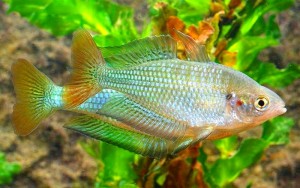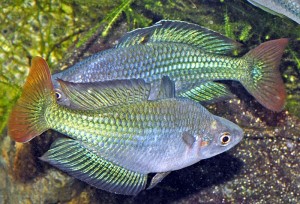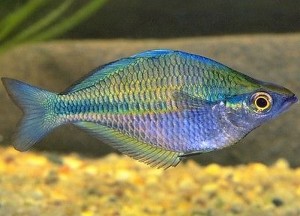The Australian Rainbowfish (Melanotaenia fluviatilis) is also referred to by tropical fish keeping enthusiasts as the Murray River Rainbowfish, Crimson-spotted rainbowfish, and Inland Rainbowfish.
Australian Rainbowfish are indigenous to Australia and can be found in the densely vegetated rivers, streams, ditches, swamps, and ponds with relatively clear, calm water. Like most rainbowfish, they tend to congregate in schools around logs, stickups and grassy riverbanks where they can easily feed on small insects and crustaceans. In the areas where they are found, the pH is normally high (8.0 or more) however, during seasonal changes they migrate into lower pH areas of around pH 6.0.
The Australian Rainbowfish is extremely hardy and very adaptable. They can endure temperatures from the low 60s to the high 70s and still remain healthy. Because of the changing , naturally harsh environments that these fish are found in, they are extremely tolerant to water condition changes and can fight off most aquarium diseases. For this reason they make a perfect starter fish for new tropical fish keeping enthusiasts.
Australian Rainbowfish have slender bodies, an arched back, two dorsal fins, and a narrow head with relatively large eyes. In adult males, the base body color is an olive green or bluish brown, sometimes with a dark horizontal striped lateral line, and a rosy pink belly.
They have rows of scales that reflect turquoise and green, and a thin reddish stripe that can sometimes be seen between the scales. The fins are all clear with a reddish tint, and along the margin of the male’s dorsal, anal, and front margin of the pelvic fin are outlined in black; especially during breeding.
During breeding, the body colors of male Australian Rainbowfish intensifies to an emerald green however, the location that the fish originated from can cause significant variations in their overall color patterns.
Female Australian Rainbowfish are a more drab version of the males.
Australian Rainbowfish do best in an aquarium that simulates their natural habitat. A densely planted tank with a sandy substrate, some bogwood and plenty of swimming space is all that is needed to keep these fish health and happy. If possible, place the tank where it can get a couple hours of sunlight during the day. They prefer hard alkaline water but will thrive in a wide range of conditions, as long as the water is well filtered and moderate water movement is provided.
Although Australian Rainbowfish do well in a community tank with other active, peaceful, similarly sized fish; they are especially suited for a single species tank with other rainbowfish of the same species. They do best in groups of at least 6 to 10 individuals that are equally male to female. Although they are generally non aggressive, they are extremely active and playful and can bully some slower swimming species. House them with other active, playful, non aggressive species for the best outcome.
Australian Rainbowfish are easy to breed however with these species, be careful with crossbreeding. In the wild, Rainbowfish will not
intermingle with other species however, in an aquarium environment, rainbowfish in the Melanotaeniidae family will interbreed. Unfortunately, the offspring are usually drab, even as adults.
The best way to breed these fish is to set up a long breeding tank with a sponge filter and a spawning mop, some Java Moss, or several fine leaved plants like cabomba.
Place a conditioned pair of Australian Rainbowfish into the tank and continue feeding them high protein foods like bloodworms, tubifex, or mosquito larvae until the female has produced eggs. When this occurs, the male will lead the female to the spawning site and then fertilize the eggs.
At this point its a good idea to remove the eggs from the breeding tank and place them into a rearing tank. The pair will repeat the breeding ritual for several days with fewer and fewer eggs being deposited until they show signs of tiring.
The fry in the rearing tank will hatch out in a week or so and after their eggs sacs have been absorbed, should be fed infusoria or liquid fry food until they are able to ingest larger fare. The fry are slow growers and need clean water during the entire rearing process. As they grow in size, they can be fed newly hatchedbaby brine shrimp and crushed flake foods.
Australian Rainbowfish are an omnivorous species that in the wild feed on aquatic invertebrates and insects that fall into the water. In an aquarium environment they should be fed a high quality flake food with occasional feedings of live, frozen, or freeze dried
bloodworms, brine shrimp, white worms or tubifex. Feed them several times a day only what they can consume in 4 or 5 minutes.
Australian Rainbowfish are sold in specialty fish shops as Inland Rainbowfish or Murray River Rainbowfish. They are usually moderately priced and somewhat difficult to obtain. They can be ordered online or through specialty tropical fish shops and are usually sold as juveniles at 1 3/4″ to 2 1/2″ in size.
Minimum Tank Size: 30 gallons
Care Level: Moderate
Temperament: Peaceful
Aquarium Hardiness: Very Hardy
Water Conditions: 70.0 to 79.0° F, 8 – 25 dGH, pH 6.5-8.5
Max. Size: 4”
Color Form: Silver, Green, Blue
Diet: Omnivore
Compatibility: OK with like size peaceful species
Origin: Northeast Australia
Family: Melanotaeniidae
Lifespan: 5-8 years
Aquarist Experience Level: Beginner






